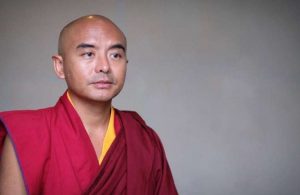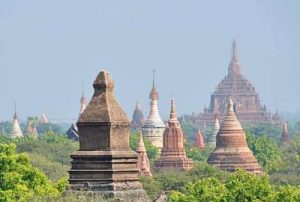From the late colonial to the post-colonial period of Bangladesh, Gyaniswer Mahāsthabir (20 December 1887–28 October 1974) was a pioneering Theravāda teacher who transmitted the Buddhist teachings to Bengali-speaking devotees. Gyaniswer Mahāsthabir tirelessly taught the Dhamma for more than six decades, with devotees honoring him with the title of aryaśrābakam (a noble disciple of the Awakened One). He was also respectfully recognized as a mahāyōgī (great meditator) by not only his disciples, but also his students, the Buddhist scholar Sīlānanda Brahmacārī (1907–2002), and the 12th saṅgharāj (supreme patriarch) of Bangladesh, Dr. Dharmasen Mahāthērō (1928–2020).
Gyaniswer Mahāsthabir was born in the village of Mukutnait, in Patiya Subdistrict of Chattogram Division, present-day Bangladesh. The newborn baby’s delighted parents, Harirāj Barua and Tārādēbī Barua, lovingly welcomed their fourth child with the name Lalita Chandra Barua. The Bengali word lalita denotes “a tender heart,” and chandra translates as “the moon.” According to the Bengali-English dictionary, Lalita Chandra refers to “a person whose face seems to be like the beauty of the moon with a full heart of loving-kindness and compassion.” The child’s parents probably assumed that he might become an altruistic and compassionate practitioner in the future, so they gave him a name that means “kind-hearted boy who shines like the moon.”

As a child, Lalita Chandra was sent to a local elementary school. He was admitted into a reputable institution, the Sanskrit Chatuspati School. After observing how well Lalita Chandra was doing, his teachers suggested that he study with better teachers. Lalita Chandra’s father sent his son to study with a prominent teacher, Ācāriẏā Rajanīkānta Kābyatīrtha. Under his mentor, he studied poetry, literature, philosophy, Indian grammar, and contemporary issues. Lalita Chandra also studied the science of Ayurveda.
At the end of his education, Lalita Chandra began his career as an expert in Ayurvedic medicine. At the age of 22, he opened a private clinic in Safar Ali Munsi Haat, Chattogram. Needless to say, within a few months, Lalita Chandra became a well-known kabirāj or doctor among locals for his thoughtful treatment of patients.
Since Lalita Chandra was doing well in his career, his parents decided to arrange a bride for their beloved son. As part of Bengali family tradition, arranged marriage is a popular custom. Despite his parents’ desire that their son marry and start his own family, Lalita Chandra was not interested in household life. During that time, Lalita Chandra saw something that greatly influenced his decision to leave family life behind. Once, while returning home from his clinic, he saw a thief being punished by a group of people. Having observed the thief’s punishment, Lalita Chandra thought that this man was probably suffering deeply because he didn’t have enough resources and was therefore resorting to theft.
Profoundly moved, Lalita Chandra decided to enter monastic life. His father initially did not agree with his son’s decision. Lalita Chandra called his nearest relatives and friends to convince his father, one of whom, Hīrāsing Barua, finally convinced Harirāj Barua. With permission from his father, young Lalita Chandra began his monastic journey, which continued until the end of his life.

In 1909, Lalita Chandra was ordained as a novice (sāmaṇera) under Śrīmat Jagaṯ Candra Mahāsthabir, a monk and abbot at the village monastery. Jagaṯ Candra Mahāsthabir was a disciple of the legendary Theravāda monk Ācārya Pūrṇācāra Candramōhana Mahāsthabir (1834–1907), the second saṅgharāj of Bangladesh. Having observed Lalita Chandra’s deepening dedication to monastic life, Jagaṯ Candra Mahāsthabir arranged a higher ordination (upasampadā) at Tegarpuni, in Patiya Sub-district of Chattogram. The preceptor (upajjhāya), Ven. Jagaṯ Candra Mahāsthabir, bestowed on Lalita Chandra the formal monastic (bhikkhu) name Gyaniswer Bhikkhu.
The term gyaniswer is made up of two parts: gyana denotes “knowledge,” while ishwer refers to “master.” The name Gyaniswer therefore means “knowledgeable master.”

After receiving full ordination (bhikkhu upasampadā), Gyaniswer Bhikkhu focused on his monastic education, which was based on the Pāḷi Tipiṭaka. Gyaniswer Bhikkhu received a letter from his spiritual friend Pranahari Bhikkhu (1880–1970), who would subsequently become renowned as Banśadīp Mahāsthabir. In the letter, Banśadīp Mahāsthabir wrote that he had been residing at Baijaẏanta Bihāra, in the city of Moulmein, Myanmar, where he had been studying with a prominent Theravāda monk, Ven. U Sāgara Mahāsthabir. Spurred on by this letter and information, Gyaniswer Bhikkhu went to Myanmar in 1910. He decided to receive full ordination for a second time under Ven. U Sāgara Mahāsthabir, his new preceptor.

Encouraged by Banśadīp Mahāsthabir, Gyaniswer Bhikkhu decided to travel to modern-day Sri Lanka. In 1912, he arrived on the island of Ceylon and began to study canonical and exegetical literature at Panadura Sad’dharmadōẏa Paribēna, under Upasēna Mahānāẏaka Sthabir. While residing in Sri Lanka, he was impressed by the monastic practices of monks, including his teacher. Gyaniswer Bhikkhu received full ordination for a third time under the eminent preceptor Ven. Sumana Mahāsthabir, who was also a teacher of Upasēna Mahānāẏaka Sthabir.
Having been exposed to multiple Vinayas and acclaimed masters in Myanmar and Sri Lanka, Gyaniswer Bhikkhu returned to his homeland in 1916. He spent his first two rain retreats (vassa) at Mukutniat and Chorkanai. In 1919, Gyaniswer Mahāsthabir began to reside at Unainpūrā Laṅkārāma, a monastery in Unainpūrā, in Patiya, Chattogram, where he remained for a long 55 years. This monastery was one of the most prominent Theravāda monasteries in Boṅgabhūmi and the Indian subcontinent, where eminent spiritual teachers came for teaching and practice.

Once he started his spiritual career at Unainpūrā Laṅkārāma, Gyaniswer Mahāsthabir tirelessly taught the Dhamma to monastics and lay devotees. He also tried to spread knowledge of the ancient Indic languages, such as Pāli and Sanskrit. For beginners of the Pāli language, Gyaniswer Mahāsthabir compiled his monumental text Pāli Prabēśa (Entrances to Study Pāli Language) in 1937. Pāli Prabēśa is still in use today as a textbook for Pāli Studies in Bangladeshi and Indian institutions, including Dhaka University, Chattogram College, Noapara Collge, and Chittagong University in Bangladesh, as well as Kolkata University of India.
Gyaniswer Mahāsthabir positioned himself as a leader to remove wrong views from Buddhist society, as well as facilitate ecumenicism and reconciliation among Theravāda Buddhist monks in Boṅgabhūmi. In Theravāda Buddhism in Bangladesh, there are two Vinaya groups among the clergy: the Saṅgharāja Nikāya and the Mahāsthabir Nikāya. The supreme patriarch from the Saṅgharāja Nikāya is known as the saṅgharāj, whereas the supreme monk from the Mahāsthabir Nikāya is known as the Saṅganāyaka. Both groups follow the same monastic codes; there is no difference regarding practice between these two schools. In 1966, the annual congregation of the Saṅgharāja Nikāya was held at Unainpūrā Laṅkārāma, which was arranged by the Bangladesh Saṅgharāja Bhikkhu Mahāsabhā organization. The agenda was for all monks to be united under one umbrella instead of having two fraternities. This reconciliation was driven by none other than Gyaniswer Mahāsthabir.

Accompanied by his spiritual friends Banśadīp Mahāsthabir and Prajñālōka Mahāsthabir (1879–1971), Gyaniswer Mahāsthabir not only taught insight meditation (vipassana) but also re-introduced traditional Buddhist events to the community, such as Buddha Puja and the robe-offering ceremony (katīna cībar dāna). The latter included offering honey and medicine to the monastic community during Madhū Pūrnīma, the full-moon day in modern-day Bangladesh. His visionary ideas and teachings deeply impacted Buddhist society, as well as enriching local cultures. Consequently, an entire generation followed him as a leader. Gyaniswer Mahāsthabir traveled to many places and villages to propagate the Buddha’s teachings, his noble intention to quell religious dogmas, correct wrong views, and defeat superstitions.

In addition to providing spiritual guidance to the community and fostering Buddhist scholasticism, Gyaniswer Mahāsthabir trained a number of Buddhist monks and scholars, who later became leaders of Theravāda Buddhism in Bangladesh and India. One of these was Sīlānanda Brahmacārī (1907–2002), who became a pioneering scholar in postcolonial India. He translated numerous Pali texts into Bengali and a number of books in both Bengali and English. His monumental translations and compilations include the Samyutta Nikaya, Visuddhimagga, Mahasanti Mahaprem, Karmayogi Kripasaran, Vipassana Yoga, Abhidharma Darpan, Abhidhamma, Dhammapada, The Eternal Message of Lord Buddha, Mangalatattha, Vipassana Sadhana, Amrita Dhara, and Antorlok Jatri Rabindranath.
Gyaniswer Mahāsthabir’s two monastic disciples became supreme patriarchs in two separate countries. Dr. Dharmasen Mahāthērō (1928–2020) was the 12th saṅgharāj of Bangladesh, whereas Dharmapāl Mahāthērō became the saṅganāyaka of India.

Āryaśrābaka Gyaniswer Mahāsthabir died on 28 October 1974, at the age of 87. His legacy deeply impacted the propagation and preservation of Theravāda Buddhism throughout Bangladesh and the Buddhist world. His light of joy rests in the hearts of Bengali-speaking monks and devotees, and of the Buddhist community across South Asia and the world.
References
Bhikkhu Bodhi. 2000. The Connected Discourses of the Buddha (Samyutta Nikaya), two volumes. Boston: Wisdom Publications.
Mahāsthabir, Dharmasen. 2009. “Kathāmṛita (Blissful Words),” In Mahājñānī Mahājana. Edited by Chandrajyoti Bhikkhu. Chattogram: Gandhara Art Press.
Mahāsthabir, Dharmasen. 2021.“Unainpūrā Laṅkārāma,” In Jyōtirmaẏa Dharmasen. Edited by Sajib Barua Diamond, Sanjoy Barua Chowdhury, et al., 436–37. Chattogram: Purba Publishing.
Mahāsthabir, Dharmādhār. 2009. “Bānlādēśe Sad’dharma Punarut’thānē Pradhāna Ācāryagana [The Contributions of Buddhist Monks for Revivaling Buddhism in Bangladesh],” in Buddhism in Bengal. Edited by Brahmanda Pratap Barua, 169–80. Kolkata: Barun Kundu.
Mahāsthabir, Gyaniswer. 1994. Pāli Prabēśa [Entrances to Study Pāli Language and Pāli Grammar]. Taiwan: The Corporate Body of the Buddha Educational Foundation.
Brahmacārī, Sīlānanda. 2009. “Mahayogi Gyaniswer,” in Mahājñānī Mahājana. Edited by Chandrajyoti Bhikkhu. Chattogram: Gandhara Art Press.
S. Gyanamitra Bhikkhu (Nipun Barua). 2011. Āryaśrābaka Gyaniswer Mahāsthabir. Chattogram: Pragati Art Press.
Chowdhury, Sanjoy Barua. 2022. Walking Into The Light of Dhamma. Songkhla: International Buddhist College, Thailand. Accessed 2 March 2023 at: http://ibc-elibrary.thanhsiang.org/node/981
Sunandapriya Bhikkhu. 2010. “Bāṅālir Paricchanna Dhārār Baud’dha” [The Pristine Heart of Bengali Buddhists], in Jagaṯjyōti. Edited by Hemendu Bikash Chowdhury. Kolkata: Dharmāṅkūra Baud’dha Sabhā.
Related features from BDG
Karmayōgī Kṛpāśaraṇa Mahāthērō (1865–1927): The Forgotten Monk Who Built Buddhism in Modern India and Bangladesh
The History and Heritage of the Buddhist Diffusion in Boṅgabhūmi
From Vajrayoginī to the Land of Snow: The Legacy of Atīśa Dīpaṃkaraśrījñāna (982–1054)













